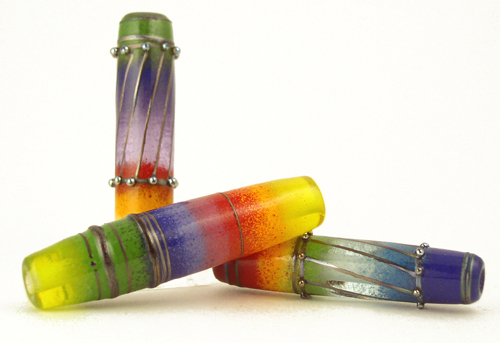
Glass beads are among the first and oldest glass objects to be found by archeologists. They have been objects of desire for thousands of years. In some cultures glass beads were strictly reserved for royalty alone. You’ll be happy to know that they are no longer reserved for just royalty, though you may feel like royalty when wearing them. I am very proud to be an artist taking part in that tradition.
Lampwork beads are typically made from soften glass rods which are wrapped around stainless steel mandrels, shaped and decorated. The mandrel then becomes the bead’s hole.
Because glass shrinks as it cools stress can form within the glass causing cracks and breakage, most stress is invisible to the naked eye. It is important to eliminate this stress by annealing the beads in a kiln. The annealing process soaks the bead at a designated temperature to relieve any internal stress, and then slowly cools the bead to prevent any new stress from developing. A bead that is not kiln annealed WILL break. A bead that is kiln annealed with be much less likely to break, but it's still glass and you must take care. You will be happy to know all of my beads are kiln annealed.

A note about mass produced, imported beads:
1) Most of the imported beads are NOT annealed, which makes their strength questionable. They are not made to last. Those who use such beads in their jewelry should be aware that they will likely break. As a jewelry designer, you cannot guarantee the durability of any jewelry made with imported beads.
2) While the quality of imported lampwork beads has improved, you should still expect imperfections. They may be minor or they may be significant, but the beads were not made with the care and attention to detail you can expect from an artist-made bead. Many designers have commented that the quality difference is immediately apparent.
3) Because of the points listed above, any jewelry made with imported lampwork should be priced accordingly. The lower quality and reduced durability of these beads transfers directly to the jewelry made with them. Therefore, it is not ethical to price jewelry without taking these factors into consideration. It’s important to ask yourself if you are really saving money by purchasing imported lampwork beads.
4) Artist-made beads are beads made by hand in a studio by an individual artist and are not mass-produced. Several of the largest producers of lampwork beads today are importing beads from India or China to the United States and reselling them under a studio name. For example, one of the most popular sellers of handmade glass beads has auction descriptions lead buyers to believe that an individual artist makes the beads in a studio. Quite the contrary! The beads sold by that company are imported to a warehouse in Canada and then resold to unsuspecting buyers. This is where I would normally advise buyers to question their sellers by asking if the beads are annealed and if artists or factory workers create them. Unfortunately, a few of the notable lampwork bead sellers have a carefully prepared “cover story” and willingly mislead buyers, even when questioned directly.
5) China is a Communist country, where working conditions include “low pay, seven-day work weeks, 15-hour working days, mandatory overtime, a poor working environment and often coercive factory regulations.” (chinalaborwatch.org) Workers frequently live in overcrowded dormitories and often earn less than 25 cents per hour. Your purchase supports labor conditions at their worst. I encourage you to buy artist-made beads, even if they are not mine. Of course, I would prefer you buy mine. (Note that this artist often works 15-hour days for low pay and as my own boss I can be quite coercive, but my working environment is mine and I love it and all the safety it has to offer... including the fact that it allows me to do what I love: lampwork!)












